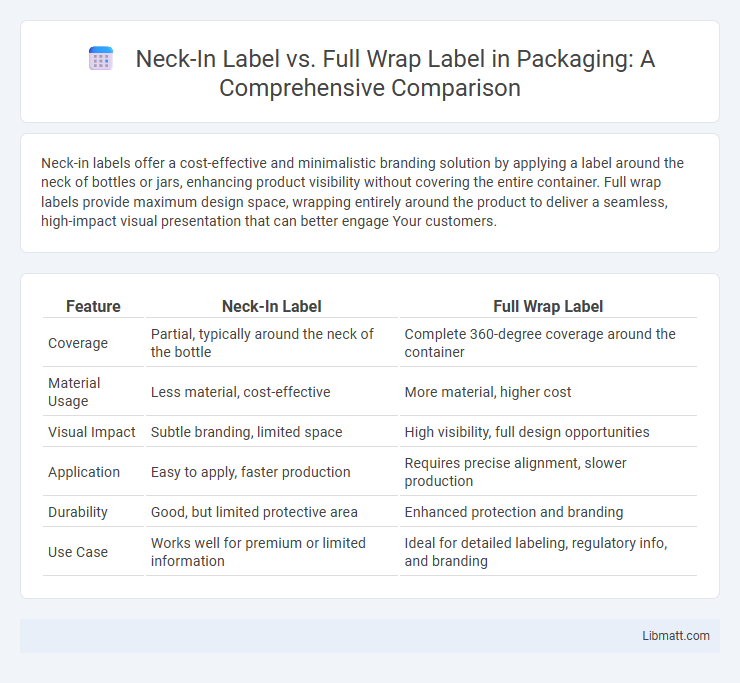Neck-in labels offer a cost-effective and minimalistic branding solution by applying a label around the neck of bottles or jars, enhancing product visibility without covering the entire container. Full wrap labels provide maximum design space, wrapping entirely around the product to deliver a seamless, high-impact visual presentation that can better engage Your customers.
Table of Comparison
| Feature | Neck-In Label | Full Wrap Label |
|---|---|---|
| Coverage | Partial, typically around the neck of the bottle | Complete 360-degree coverage around the container |
| Material Usage | Less material, cost-effective | More material, higher cost |
| Visual Impact | Subtle branding, limited space | High visibility, full design opportunities |
| Application | Easy to apply, faster production | Requires precise alignment, slower production |
| Durability | Good, but limited protective area | Enhanced protection and branding |
| Use Case | Works well for premium or limited information | Ideal for detailed labeling, regulatory info, and branding |
Introduction to Labeling Techniques
Neck-in labels are smaller adhesive strips applied near the bottle neck, offering a minimalist design that enhances brand visibility without covering the entire surface. Full wrap labels encircle the entire bottle, providing a larger canvas for detailed graphics and comprehensive branding messages. Both techniques optimize product presentation and consumer engagement depending on packaging design and marketing goals.
What is a Neck-In Label?
A Neck-In label is a type of product label that is placed around the neck of a bottle or container, typically smaller and designed to fit snugly below the cap area. It differs from a full wrap label that covers the entire body of the bottle, providing a more subtle branding option that highlights key product information without overwhelming the packaging. These labels are commonly used in the beverage industry to enhance shelf appeal and provide additional marketing space near the bottle opening.
What is a Full Wrap Label?
A full wrap label entirely encircles a bottle or container, providing 360-degree coverage that maximizes branding and design space. Unlike neck-in labels that only cover a portion near the neck of the bottle, full wrap labels offer seamless, edge-to-edge graphics for enhanced visual impact and product information. Your product benefits from increased shelf appeal and protection with this comprehensive labeling solution.
Material and Printing Differences
Neck-in labels are typically made from thinner materials like BOPP or paper, allowing for easy application around bottle necks, whereas full wrap labels use thicker films such as PVC or PET for durability and full surface coverage. Printing techniques for neck-in labels often include flexographic or digital printing optimized for smaller label sizes, while full wrap labels utilize high-resolution rotogravure or digital printing to achieve vibrant, continuous designs. Material choice and print methods affect label flexibility, adhesion, and visual impact, influencing the packaging's overall aesthetic and protection.
Application Processes Compared
Neck-in labels are applied post-bottle formation using pressure-sensitive adhesives, allowing precise placement around the neck and easy removal from inventory due to smaller label sizes. Full wrap labels require shrink sleeve technology involving heat tunnels or steam to conform the label around the entire bottle body, providing 360-degree coverage but necessitating more complex equipment. The simpler application process of neck-in labels suits smaller production runs, while full wrap labels are preferred for high-speed, high-volume operations demanding complete surface branding.
Visual Impact and Branding
Neck-in labels provide a subtle, sophisticated branding element that draws attention to the product's neck area, enhancing visual appeal without overwhelming the overall design. Full wrap labels offer maximum space for vibrant graphics and detailed information, creating a bold, eye-catching statement that can effectively convey brand identity. Your choice between the two should consider how prominently you want your branding to stand out on the shelf and the complexity of your visual messaging.
Cost Analysis: Neck-In vs Full Wrap
Neck-in labels generally offer a more cost-effective solution compared to full wrap labels due to their smaller size and reduced material usage. Full wrap labels require more adhesive and higher-quality printing to cover the entire bottle, increasing production costs. You can optimize your packaging budget by selecting neck-in labels when budget constraints are a priority without compromising on brand visibility.
Sustainability and Environmental Factors
Neck-in labels use less material and generate less waste compared to full wrap labels, making them a more sustainable choice for packaging. Full wrap labels cover the entire container, often requiring more adhesive and resources, which can increase environmental impact. Choosing neck-in labels can reduce your carbon footprint by minimizing plastic use and improving recyclability.
Suitability for Different Packaging Types
Neck-in labels are ideal for bottles with narrow necks and limited labeling space, providing a clean, professional appearance primarily on beverages like wine or spirits. Full wrap labels encircle the entire container, making them suitable for cylindrical packages such as cans and jars, offering maximum branding area and 360-degree product information. Choosing between neck-in and full wrap labels depends on the container shape, brand visibility goals, and the amount of required product detail.
Choosing the Right Label for Your Product
Choosing between neck-in labels and full wrap labels depends on your product's design and branding goals. Neck-in labels provide a sleek, minimal look by wrapping around the bottle's neck, ideal for showcasing logos or key information without overwhelming the bottle's main body. Full wrap labels cover the entire bottle, offering maximum space for detailed graphics and brand storytelling, making them perfect for products that require standout shelf presence and comprehensive labeling.
Neck-in label vs full wrap label Infographic

 libmatt.com
libmatt.com